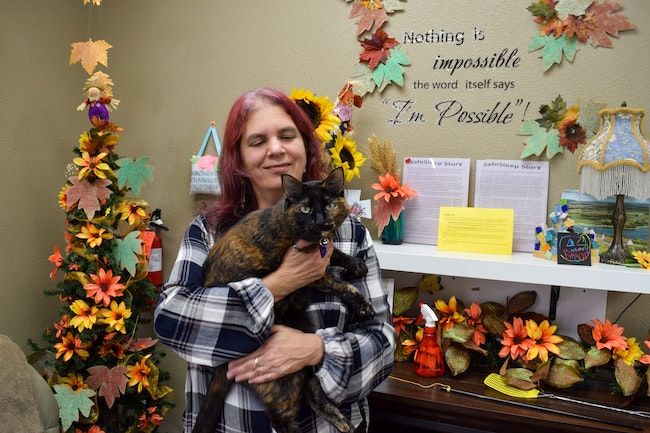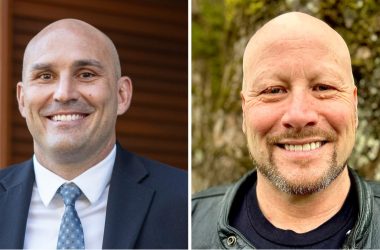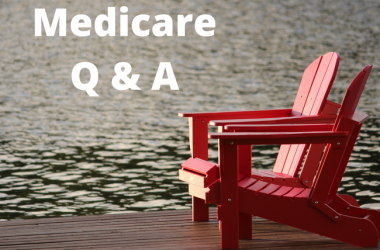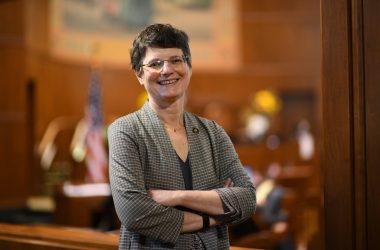
Lynelle Wilcox holds the shelter cat, Athena, at Safe Sleep women’s shelter on Oct. 29, 2021. (Saphara Harrell/Salem Reporter)
When Theresa Gettmann’s roommates moved out in September 2020, she ended up homeless.
She wasn’t on the lease and couldn’t find another place to live without an ID or a job.
She went to Wallace Marine Park to camp at first, which she described as ‘terrifying.’ Then she went to Cascades Gateway Park and said her tent was burned down intentionally.
“There’s a lot more violence towards (women) out there,” she said. “A lot more sexual violence and things like that most men don’t have to worry about so much.”
Gettmann was one of 1,309 women who were unsheltered or living in emergency shelter in the Marion and Polk County area from July 2020 through Oct. 31, 2021.
There were 1,219 men and 52 people who chose not to provide gender information during that same period.
That means women represent more than half of the people experiencing homelessness in the area, which is higher than state and national averages.
According to the federal Housing and Urban Development’s 2018 Point in Time count, 34% of people experiencing homelessness in Oregon are women. Nationwide, that number is 29%. The count is known to historically undercount the homeless population because of the difficulty locating people.
The local numbers provided to Salem Reporter come from the local Homeless Management Information System, which is a more accurate count of the number of people who are experiencing homelessness.
When Jimmy Jones was vetting clients for a program that aimed to pull homeless people considered “the hardest to house” off the street, nearly half of the assessments he did were women.
Jones, executive director of the Mid-Willamette Valley Community Action, interviewed 50 women to determine how vulnerable they were to staying unsheltered.
“The kinds of stories that people told were so devastating and so painful I had to go to therapy myself for it,” he said. “The amount of violence women are exposed to living with partner on partner, sexual violence, the trafficking that goes on. The stories we’ve heard over time are just crushing.”
Jones said if you excluded women fleeing from domestic violence, 40% of those who are homeless in the area are women.
“That is the thing that’s shocking to me,” he said. “Part of it may just be that we’re doing a better job of outreach and engagement.”
 Rachel Miller and Matt Herbert walk into a field near Interstate 5 for the annual count of Salem’s unsheltered on Jan. 6, 2021. (Saphara Harrell/Salem Reporter)
Rachel Miller and Matt Herbert walk into a field near Interstate 5 for the annual count of Salem’s unsheltered on Jan. 6, 2021. (Saphara Harrell/Salem Reporter)
Women shelter
Jones said part of the reason there are so many women on the streets is that the Salem area has very little female-specific shelter.
Many serve families like St. Francis Shelter, which provides transitional housing for about 22 formerly homeless families. Church at the Park opened a second micro-shelter community in northeast Salem adjacent to a warming shelter that’s intended to serve families.
Grace House provides transitional housing for six women in recovery from addiction.
Center for Hope and Safety serves survivors of domestic violence. During Covid the nonprofit put some families in motels and had 15 beds at its shelter.
Simonka Place, run by Union Gospel Mission, was the first women’s only shelter in the Salem area and has been serving women for decades.
Kathy Smith, director of Simonka Place, said the shelter averages 62 women each night because of statewide Covid restrictions still in place for shelters.
Before Covid, the shelter could house 93 to 115 women.
It is frequently full.
From September 2020 to August 2021, the shelter turned away 659 women and 279 children because it was completely full.
The year before that, the shelter turned away 1,121 women and 573 children.
Smith said that doesn’t include a period time from March to June 2020 when the shelter wasn’t doing intakes because of Covid.
“We are always full, we are always turning people away,” she said.
Cindy Souza tried for three months to get into Simonka until they had an opening.
She was laid off from a job in the hospitality industry at the start of the pandemic. She stayed at Simonka until she found a place to rent.
“When Covid happened, it’s been one heck of a rollercoaster,” she said.
She said the room she rented ended up becoming unsafe because people were using drugs, so she came back to the shelter.
There, she feels she’s where she’s supposed to be. Souza said she has a huge support system at the shelter which is helping her deal with her son’s recent hospitalization from severe burns.
“If I were on the streets having to deal with that it would be nearly impossible,” she said.
 Rachel Miller and Donna Megi survey Jessica Hickock for the annual point in time count of the area’s unsheltered on Jan. 26, 2021. (Saphara Harrell/Salem Reporter)
Rachel Miller and Donna Megi survey Jessica Hickock for the annual point in time count of the area’s unsheltered on Jan. 26, 2021. (Saphara Harrell/Salem Reporter)
Mental health
Simonka has seen recent success moving families into housing.
In September and October, 32 women and 13 children were able to find permanent housing and leave the shelter, Smith said.
She also said the number of women experiencing severe mental health issues has skyrocketed in the shelter.
“We’re not a huge shelter but what we have seen is probably that one out of every three women has severe mental health issues. Before (four years ago) it was one out of 10,” she said.
Lynelle Wilcox works at Safe Sleep, a low-barrier women’s shelter that opened in December 2019 to serve women. Low barrier means women don’t have to be sober to get a bed and can come with pets.
In its first year, the shelter provided a bed for 185 women.
Wilcox came from a job as a benefits counselor, helping people find jobs no matter their disability.
Safe Sleep doesn’t require women to get jobs, but in the back of her mind Wilcox thought she could direct some women to employment.
She would see women come in who could organize, clean up and replenish supplies.
“I think, ‘Hell, you could run an office,’ but if I look at you wrong, I’m talking about you. If I say something and then stop talking, clearly, I was saying something about you. So, the life skills and the trauma and the paranoia that can come from being in that fight or flight mode for so long, those are the things that I’m realizing become the barriers to employment,” she said.
Wilcox said working in her role made her realize how deeply trauma can impact people’s lives.
“I came from a strong background that disability does not prevent employment. Now I’m feeling like extreme poverty, and abuse and trauma really can limit somebody’s ability to be employable,” she said.
Statistics provided to Salem Reporter show that of the 185 women who stayed at the shelter, more than half have a mental health condition and 42% have a physical health condition.
Wilcox recounted a story about a woman who came to stay at the shelter who was “effectively blind,” unable to see the bed or toilet bowl.
Wilcox told her she could stay the night, but the shelter didn’t have the staffing to walk her from place to place.
“I asked her, ‘What happened to your eyes?’ She said she was staying by Rite Aid and a woman came by sprayed her eyes with sulfuric acid,” she said.
Wilcox said there are circumstances where women aren’t the breadwinners in a relationship, which can make leaving difficult.
“So, you’re going to be more vulnerable financially if you lose your person. Even if it’s a violent person and you should get away from him, you’re going to be more vulnerable if you haven’t been actively working and then trying to develop some work history or work skills when you’re coming from trauma at that point,” she said.
Jones said it’s very uncommon to find women who have been homeless for more than a year who haven’t been the victim of some kind of sexual violence.
More than 80% of homeless mothers with children reported previously experiencing domestic violence, according to a report from the National Center for Children in Poverty.
Transgender people, particularly transgender women, are also subject to violence while homeless. One in five transgender people have experienced homelessness at some point in their lives, according to the National Center for Transgender Equality.
“They’ve been targets for repeated victimization over the years,” Jones said.
He said many women become homeless in their youth, perhaps running away from abuse in their home, and ending up unstably housed. That’s also true of transgender women and other trans young people.
“People are subjected to that kind of abuse and looking to get out by any means necessary. They make poor choices about friends and partners that make it worse,” Jones said.
Gettmann, the woman who had her tent burned down, is now enrolled in the New Life Fellowship program at Simonka Place, a voluntary, long-term program that helps women recover from addiction in a faith-based setting.
After she finishes the program, which she’s been in since June, she said she wants to go to school for drug and alcohol counseling with a specialization in human trafficking and domestic violence.
“Hopefully my experiences can help others,” she said.
She said there needs to be more advocacy for women who are homeless. She felt her concerns were brushed off because she’s a woman.
“For me a lot of it was reporting things and not being heard. Going for help, because you’re an addict, because you’re a woman you tend to be pushed off,” she said.
Contact reporter Saphara Harrell at 503-549-6250, [email protected].
JUST THE FACTS, FOR SALEM – We report on your community with care and depth, fairness and accuracy. Get local news that matters to you. Subscribe to Salem Reporter starting at $5 a month. Click I want to subscribe!









